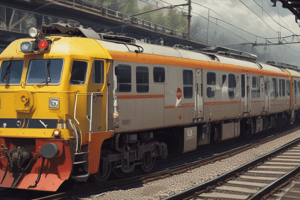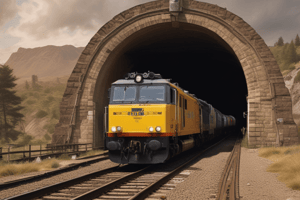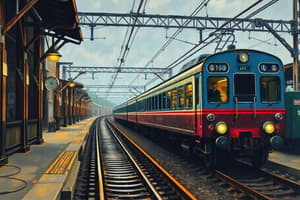Podcast
Questions and Answers
Which of the following is NOT a category included in the classification of level crossings?
Which of the following is NOT a category included in the classification of level crossings?
- Normal Position of Gates
- Emergency Level Crossings (correct)
- Traffic and Engineering Gates
- Skew Level Crossings
What should be included in the maintenance examination of level crossings?
What should be included in the maintenance examination of level crossings?
- Reassessment of railway timetables
- Review of traffic flow regulations
- Assessment of surrounding road surface
- Inspection of lockdown mechanisms (correct)
Which type of patrol is specifically conducted during abnormal weather conditions?
Which type of patrol is specifically conducted during abnormal weather conditions?
- Infrastructure Patrol
- Security Patrol
- Gang Patrol (correct)
- Keyman’s Daily Patrol
In the event of an accident, who should the incident be reported to?
In the event of an accident, who should the incident be reported to?
What is a key consideration for the appointment of gatemen at level crossings?
What is a key consideration for the appointment of gatemen at level crossings?
What is a critical factor in determining the safe speed on curves?
What is a critical factor in determining the safe speed on curves?
What is the purpose of super-elevation in curves?
What is the purpose of super-elevation in curves?
Which of the following is NOT a part of the long welded rails (LWR) process?
Which of the following is NOT a part of the long welded rails (LWR) process?
What should NOT be allowed over turnouts on curves?
What should NOT be allowed over turnouts on curves?
What is a recommended practice for maintaining long welded rails?
What is a recommended practice for maintaining long welded rails?
What does the acronym SEJ stand for within the context of rail systems?
What does the acronym SEJ stand for within the context of rail systems?
What is a common occurrence that requires rectification in rail systems?
What is a common occurrence that requires rectification in rail systems?
Which condition is specifically addressed when discussing the conversion of short welded rails into long welded rails?
Which condition is specifically addressed when discussing the conversion of short welded rails into long welded rails?
What does the term 'Turnout' refer to in railway terminology?
What does the term 'Turnout' refer to in railway terminology?
Which factor is critical when measuring rail wear on sharp curves?
Which factor is critical when measuring rail wear on sharp curves?
What is the purpose of the Track Quality Index (TQI)?
What is the purpose of the Track Quality Index (TQI)?
What is a primary benefit of robotic reconditioning of switches and crossings?
What is a primary benefit of robotic reconditioning of switches and crossings?
Which method is mentioned for systematic track maintenance?
Which method is mentioned for systematic track maintenance?
What role do track recording cars (TRC) play in railway maintenance?
What role do track recording cars (TRC) play in railway maintenance?
Which of the following parameters is used for track tolerances?
Which of the following parameters is used for track tolerances?
What does 'picking up slacks' refer to in track maintenance?
What does 'picking up slacks' refer to in track maintenance?
What should the SSE/P.Way (In-charge) do during routine inspections?
What should the SSE/P.Way (In-charge) do during routine inspections?
What is Destressing Temperature (td)?
What is Destressing Temperature (td)?
What action must be taken if rail temperatures exceed the limit during maintenance work on LWR/CWR?
What action must be taken if rail temperatures exceed the limit during maintenance work on LWR/CWR?
Which of the following is a responsibility of the SSE/P.Way (In-charge)?
Which of the following is a responsibility of the SSE/P.Way (In-charge)?
At what temperature range is the Destressing Temperature (td) set for rail sections heavier than 52 kg/m?
At what temperature range is the Destressing Temperature (td) set for rail sections heavier than 52 kg/m?
What is required when excessive tree growth threatens the track?
What is required when excessive tree growth threatens the track?
What does Mean Annual Rail Temperature (tm) represent?
What does Mean Annual Rail Temperature (tm) represent?
What is crucial for the proper functioning of LWR/CWR according to the SSE/P.Way (In-charge)?
What is crucial for the proper functioning of LWR/CWR according to the SSE/P.Way (In-charge)?
What is the Stress-Free Temperature (t0) of a rail?
What is the Stress-Free Temperature (t0) of a rail?
Which of the following responsibilities does NOT belong to the SSE/P.Way (In-charge)?
Which of the following responsibilities does NOT belong to the SSE/P.Way (In-charge)?
What does the term 'Shift' refer to in rail terminology?
What does the term 'Shift' refer to in rail terminology?
What is the Prevailing Rail Temperature (tp) used for?
What is the Prevailing Rail Temperature (tp) used for?
In the case of buckling or wash-away incidents, who is responsible for the restoration of traffic?
In the case of buckling or wash-away incidents, who is responsible for the restoration of traffic?
What role does a Rail Tensor play in rail configuration?
What role does a Rail Tensor play in rail configuration?
What must the SSE/P.Way (In-charge) ensure regarding the staff dealing with LWR/CWR maintenance?
What must the SSE/P.Way (In-charge) ensure regarding the staff dealing with LWR/CWR maintenance?
How is the rate of change of Cant defined?
How is the rate of change of Cant defined?
What is the primary responsibility of JE/SSE/P.Way (Sectional) in terms of staff coordination?
What is the primary responsibility of JE/SSE/P.Way (Sectional) in terms of staff coordination?
What is included in the responsibilities of JE/SSE/P.Way (Sectional) regarding training?
What is included in the responsibilities of JE/SSE/P.Way (Sectional) regarding training?
How often should SSE/P.Way (In-charge) perform foot inspections in sections with a speed above 110 Kmph?
How often should SSE/P.Way (In-charge) perform foot inspections in sections with a speed above 110 Kmph?
What actions should JE/SSE/P.Way (Sectional) take during emergencies?
What actions should JE/SSE/P.Way (Sectional) take during emergencies?
What is one of the maintenance responsibilities of JE/SSE/P.Way (Sectional) regarding station yards?
What is one of the maintenance responsibilities of JE/SSE/P.Way (Sectional) regarding station yards?
What is a key observation point for JE/SSE/P.Way (Sectional) during the passing of trains?
What is a key observation point for JE/SSE/P.Way (Sectional) during the passing of trains?
Which types of inspections are specified for the SSE/P.Way (In-charge) according to the provided schedule?
Which types of inspections are specified for the SSE/P.Way (In-charge) according to the provided schedule?
What should JE/SSE/P.Way (Sectional) do to ensure proper material storage in station yards?
What should JE/SSE/P.Way (Sectional) do to ensure proper material storage in station yards?
Flashcards
Track Gauge
Track Gauge
The distance between two rails on a track, measured perpendicular to the direction of the track, at the top of the rails where the wheels run.
Axle Counter
Axle Counter
A device or method used to detect the presence or absence of an axle passing over it, and to count the number of axles.
Super-elevation
Super-elevation
The difference in elevation between the outer and inner rails of a curved track, designed to counteract the centrifugal force acting on a train.
Transition Curve
Transition Curve
Signup and view all the flashcards
Cant Deficiency
Cant Deficiency
Signup and view all the flashcards
Cant Excess
Cant Excess
Signup and view all the flashcards
Safe Speed on Curves
Safe Speed on Curves
Signup and view all the flashcards
De-stressing of LWR
De-stressing of LWR
Signup and view all the flashcards
Mechanized Track Maintenance
Mechanized Track Maintenance
Signup and view all the flashcards
Modified Three Tier System of Track Maintenance
Modified Three Tier System of Track Maintenance
Signup and view all the flashcards
Picking Up Slacks
Picking Up Slacks
Signup and view all the flashcards
Through Packing by Conventional Manual Method
Through Packing by Conventional Manual Method
Signup and view all the flashcards
Observance of Sleepers under Passage of Traffic
Observance of Sleepers under Passage of Traffic
Signup and view all the flashcards
Systematic Overhauling
Systematic Overhauling
Signup and view all the flashcards
Classification of Level Crossings
Classification of Level Crossings
Signup and view all the flashcards
Categories of Roads
Categories of Roads
Signup and view all the flashcards
Standards for Level Crossings
Standards for Level Crossings
Signup and view all the flashcards
Action During Accidents (Including Breaches)
Action During Accidents (Including Breaches)
Signup and view all the flashcards
Examination of Site and Preparation of Sketches
Examination of Site and Preparation of Sketches
Signup and view all the flashcards
Destressing Temperature (td)
Destressing Temperature (td)
Signup and view all the flashcards
Installation Temperature (ti)
Installation Temperature (ti)
Signup and view all the flashcards
Mean Annual Rail Temperature (tm)
Mean Annual Rail Temperature (tm)
Signup and view all the flashcards
Prevailing Rail Temperature (tp)
Prevailing Rail Temperature (tp)
Signup and view all the flashcards
Stress-Free Temperature (t0)
Stress-Free Temperature (t0)
Signup and view all the flashcards
Rail Tensor
Rail Tensor
Signup and view all the flashcards
Rate of change of Cant
Rate of change of Cant
Signup and view all the flashcards
Sand Hump
Sand Hump
Signup and view all the flashcards
SSE/P.Way's Maintenance Supervision
SSE/P.Way's Maintenance Supervision
Signup and view all the flashcards
Track Patrolling Responsibilities
Track Patrolling Responsibilities
Signup and view all the flashcards
Traffic Restoration After Incidents
Traffic Restoration After Incidents
Signup and view all the flashcards
Maintenance of Track Components
Maintenance of Track Components
Signup and view all the flashcards
Execution of De-stressing and Welding
Execution of De-stressing and Welding
Signup and view all the flashcards
Recording Rail Temperatures
Recording Rail Temperatures
Signup and view all the flashcards
Imposing Speed Restrictions
Imposing Speed Restrictions
Signup and view all the flashcards
SSE/P.Way's Knowledge of LWR/CWR
SSE/P.Way's Knowledge of LWR/CWR
Signup and view all the flashcards
Coordination with other departments
Coordination with other departments
Signup and view all the flashcards
Reporting structure
Reporting structure
Signup and view all the flashcards
Training and supervision
Training and supervision
Signup and view all the flashcards
Emergency response
Emergency response
Signup and view all the flashcards
Action during extreme weather
Action during extreme weather
Signup and view all the flashcards
Inspecting ongoing works
Inspecting ongoing works
Signup and view all the flashcards
Station yard upkeep
Station yard upkeep
Signup and view all the flashcards
Track movement monitoring
Track movement monitoring
Signup and view all the flashcards
Study Notes
Railway Track Maintenance and Operations
-
Short Welded Rails (SWR): Procedures for laying, gap surveys, creep adjustments, and maintenance are outlined in sections 317-324.
-
Long Welded Rails (LWR): Sections 325-348 detail LWR laying, welding, gaps at expansion joints, de-stressing, and maintenance. Locations for LWR/Continuous Welded Rails (CWR) are specified. Thermal forces, measurement of rail temperature, and temperature records are crucial aspects.
Curves and Turnouts
-
Curves: Radius determination, reference rails, safe speeds, super-elevation, transition curves, and indicators are covered (sections 401-417). Compensation for curvature on gradients and vertical curves are addressed. Realignment of curves and considerations for double or multiple lines, rail cutting, joints, and check rails are noted. Wear on outer rails, measurement of rail wear on sharp curves, and extra clearance are also discussed.
-
Points and Crossings: Turnouts and turn-in curves, assembly drawings, LWR use, inspection, maintenance, reconditioning, periodic inspections, robotic reconditioning, and switch rail grinding machines (SRGM) are described (sections 426-433).
Track Monitoring and Tolerances
-
Track Monitoring: General overview (section 501). Track recording cars (TRC), calibration, recording, speed, accompany staff, frequency of recording, recorded parameters, reporting procedures, remedial actions, and indices (sections 502-512) are discussed. Oscillation monitoring systems (OMS) are also included, along with recording frequencies and defect classifications. Oscillograph cars and their use in recordings are elaborated (sections 513-518).
-
Track Tolerances: General (section 519). Tolerances for new track, planning of maintenance, maintenance limits for different speed bands, actions based on TRC results, realignment criteria for curves, track parameters in floating conditions, and low speeds are outlined. Lastly, train stability against derailments is covered(sections 520-527).
Track Maintenance
- Regular Track Maintenance: Maintenance details, annual programs, rolling block programs, and mechanized track maintenance systems are included (sections 601-609). Modified three-tier track maintenance systems and systematic tamping methods for plain track and points & crossings, picking-up slacks, through packing, observation of sleepers under traffic, and systematic overhauling are also addressed.
Level Crossings and Gate Men
- Level Crossings: Location, classifications of level crossings, categories of roads, standards and gates/locking arrangements, skew crossings, gate positions, signals for road users, equipment, gatehouse locations, gateman appointments, maintenance, registers, indicators, speed breakers, traffic census, track structure, highway/road level crossings, and replacement criteria for level crossings (sections 901-921) are included.
Patrolling of Railway Lines
- Patrolling: Types of patrolling, keyman's daily patrol, gang patrol during abnormal weather, monsoon patrolling, hot/cold weather patrolling for LWR/CWR, watchmen at vulnerable locations, security patrolling for civil disturbances and special occasions (sections 1001-1007)
Accidents, Breaches, and Pre-Monsoon Precautions
- Actions During Accidents Including Breaches: Rules for observance, reporting to station master/in-charge, accidents impairing through traffic, site actions, reports to principal chief engineer, police attendance, site examination, sketches, recording details, and data usage (sections 1101-1109).
Additional Notes
-
Rail Temperature: Calculations for de-stressing temperature (td), installation temperature (ti), mean annual rail temperature (tm), prevailing rail temperature (tp), and stress-free temperature (t0) are also given (section involving specifics from rail installation process and maintenance).
-
Specific Section and Individual's Responsibilities: Various railway personnel responsibilities are shown covering supervision, emergencies and maintenance duties (sections detailing responsibilities of specific staff).
-
Inspection Tables Provide Schedules: Provides crucial information on inspection schedules with corresponding item lists for foot inspections and trolley inspections (Table-1B).
Studying That Suits You
Use AI to generate personalized quizzes and flashcards to suit your learning preferences.




